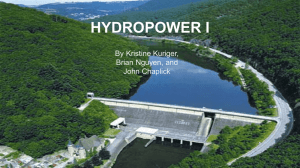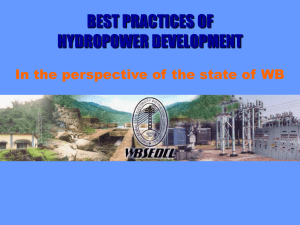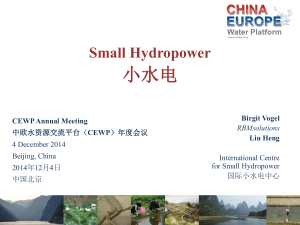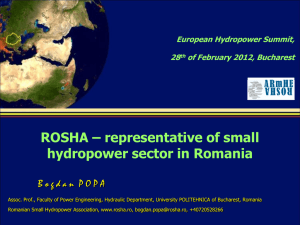Hydropower - Heartland Community College
advertisement
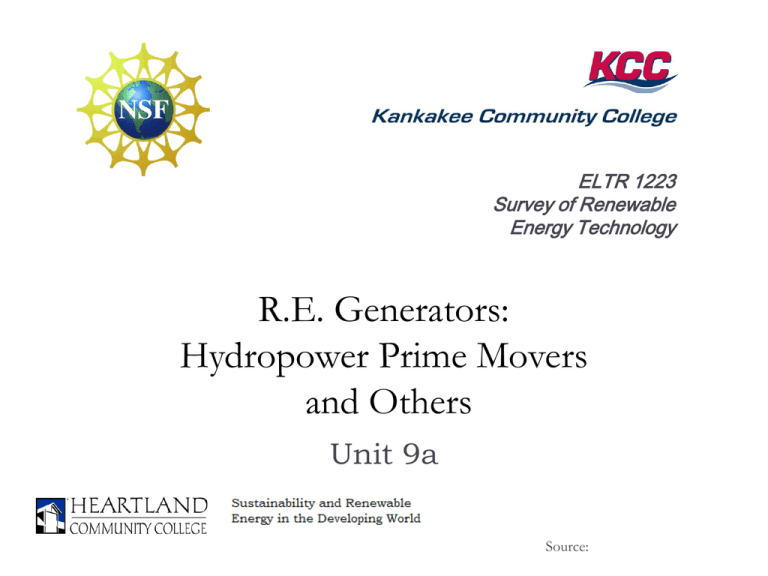
ELTR 1223 Survey of Renewable Energy Technology R.E. Generators: Hydropower Prime Movers and Others Unit 9a Source: Use Policy This material was developed by Timothy J. Wilhelm, P.E., Kankakee Community College, with funding from the National Science Foundation as part of ATE Grant No. 0802786. All materials in this presentation are designed and intended for educational use, only. They may not be used for any publication or commercial purposes. Source: Author, Editors/Reviewers Author: Timothy J. Wilhelm, P.E., Kankakee Community College Editors/Reviewers / Modifiers: Chris Miller Heartland Community College Source: Objectives Students will be able to describe, in very simple terms, the so-called hydrologic cycle, and its relationship to hydropower technology. Students will be able to name a “kinetic” type of water turbine, and briefly describe, in very simple terms, how it operates. Students will be able to name a “water-head” type of water turbine, and briefly describe, in very simple terms, how it operates. Source: Objectives Students will be able to mathematically convert feet of water head into pounds-per-square-inch of pressure Students will be able to describe, in very simple terms, at least one method of extracting energy from the ocean. Source: Hydro Power History Hydropower History Hydropower used by the Greeks to turn water wheels for grinding wheat into flour, more than 2,000 years ago. Mid-1770s -- French hydraulic and military engineer Bernard Forest de Bélidor wrote Architecture Hydraulique, a four-volume work describing vertical- and horizontal-axis machines. Hydropower History Source: http://www.uni-bielefeld.de/lili/personen/fleischmann/d_archsuse05/210_constable_mill.jpg Hydropower History Hydropower History Hydro Electric Beginnings Hydroelectric Beginnings 1880 -- Michigan's Grand Rapids electricity (DC) generated by a dynamo belted to a water turbine at the Wolverine Chair Factory, lit up 16 Brusharc lamps. Hydroelectric Beginnings 1881 -- Niagara Falls city street lamps powered by a brushed dynamo connected to an old flour mill drive. Hydroelectric Beginnings 1882 -- Hydroelectric power plant operating on the Fox River in Appleton, Wisconsin. Source: http://kids.americancorners.or.kr/ENG/images/05_history_07_10_01.jpg The War of the Currents The Wizard Who Spat on the Floor Source: http://images1.wikia.nocookie.net/__cb20100410182815/uncyclopedia/images/thumb/c/ce/Edisonx2.jpg/150pxEdisonx2.jpg The Eccentric Serb Source: http://upload.wikimedia.org/wikipedia/commons/thumb/8/87/Teslathinker.jpg/220px-Teslathinker.jpg Source: http://www.pbs.org/tesla/res/images/390414_b.gif Source: http://www.b92.net/news/pics/2006/07/118552926044aa6e07b13ae812180880_200x235.jpg Source: http://api.ning.com/files/6Uhv8JceS2ky6Hdh4qxdKFytN5dyrB2D4O0CUpyZCHrOUKLK80jCdtyHeWAuJa945 Y8s14QBfoB0pXnJA-cyJ-RXj6IiMqal/93033884.bin?width=136 “In 1492 Columbus sailed the ocean blue…” The 1893 Columbian Exposition, World’s Fair, Chicago Source: http://www.acenor.cl/acenor/pag.gral/documentos/historia_electricidad_archivos/Chicago1.jpg Niagara Falls – Nov. 16, 1896 – Westinghouse and Tesla Send Electric Power to Buffalo, NY Hydro Power Fundamentals Solar Energy + Force of Gravity = Hydropower Hydropower Fundamentals Kinetic-type primer movers “Water Wheels” Extract energy from stream-flow Head or Pressure-type Prime Movers High (inlet) Elevation – Low (discharge) Elevation = “Head” PSI(pressure) = Feet of Water (head) X 0.433 “A pint’s a pound the world around.” 1 Ft3 = 7.48 gallons; 1 gallon = 8.34 pounds 8.34 lbs/gal x 7.48 gal/ft3 x 1 ft2 / 144 in2 = 0.433 Hydropower Fundamentals Hydro Prime Mover Types: Head-type Turbines Low-Head and High-Flow “Reaction Turbines” Kinetic turbines (water wheels, and other flow converters) Propeller turbines Francis turbines (like a squirrel-cage centrifugal turbine) High-Head and Low-Flow “Impulse Turbines” Pelton Turbines Cross-flow Turbines Turbine Types and Applications 300 Meters 984 Feet 30 Meters 98 Feet or 5 Meters 16 Feet Hydro Prime Mover Types: Kinetic Source: http://hydropower.navajo.cz/hydropower-2.jpg Low-Head Propeller Turbine Low-Head = less than 16 feet Source: http://upload.wikimedia.org/wikipedia/commons/thumb/d/d0/Hydroel ectricTurbineRunner.png/300px-HydroelectricTurbineRunner.png Medium Head Francis Runner Source: http://www.capture3d.com/Images/Applications/turbines3DmeasureFig9.jpg High Head Pelton Turbine Tesla Designed a Total System Bladeless hydro-frictional turbine 3-Phase alternator Distribution transformers Wireless transmission of electric power, to all points on the earth World peace and harmony Tesla’s Frictional Turbine Source: http://static.howstuffworks.com/gif/tesla-turbine-4.jpg Creating Water Head: Impoundment Source: http://media.thesolarguide.com/i/illust_howworks.gif Creating Water Head: Diversion Source: http://gator787.hostgator.com/~reapmgmt/wp-content/uploads/2009/04/diversionhydro-280x213.jpg Hydro Plant Sizes Large Hydropower Although definitions vary, DOE defines large hydropower as a capacity of more than 30 MW. Small Hydropower Although definitions vary, DOE defines small hydropower as a capacity of 100 KW to 30 MW. Micro Hydropower A micro hydropower plant has a capacity of up to 100 kilowatts. A small or micro-hydroelectric power system can produce enough electricity for a home, farm, ranch, or small village. Micro-Hydro Micro Hydro Typically need at least 3 feet of head and 20 gpm of flow Harris Micro-hydro Source: http://www.firemountainsolar.com/pics/home_harrisCollageSM.jpg Stream Engine Micro-hydro Micro-hydro Installation Head (feet) x Flow (gpm) / 10 = Watts [For example, 30 gpm x 100 feet/ 10 = 300 watts] Other Hydro-Related Prime Movers Ocean Energy The tidal forces and thermal storage of the ocean provide a major energy source Wave action adds to the extractable surface energy Major ocean currents (like the Gulf Stream) may be exploited to extract energy with rotors Source: http://www.yourgreendream.com/images/articles/wp_wave.jpg Ocean Energy: Tidal Energy Tides are produced by gravitational forces of the moon and sun and the Earth’s rotation Existing and possible sites: France: La Rance river estuary 240 MW station England: Severn River Canada: Passamaquoddy in the Bay of Fundy (1935 attempt failed) California: high potential along the northern coast Environmental, economic, and esthetic aspects have delayed implementation Barage Tidal Power Tidal-Stream Generators Source: http://www.metaefficient.com/wp-content/uploads/seagen_marine_current_turbine.jpg Tidal-Stream Generators Source: http://upload.wikimedia.org/wikipedia/commons/thumb/7/77/SeaGen_installed.jpg/200px-SeaGen_installed.jpg Tidal-Stream Generators Ocean Energy: Wave Energy Salter “ducks” rock up and down as the wave passes beneath it. This oscillating mechanical energy is converted to electrical energy A Wavegen, wave-driven, air compressor or oscillating water column (OWC) spins a two-way Wells turbine to produce electricity Wave Power Source: http://www.kitco.com/ind/K irtley_Sam/images/may17 2007_2.jpg Source: http://www.rise.org.au/info/Tech/wave/image002.gif Ocean Energy: OTEC (Ocean Thermal Electric Conversion) OTEC requires some 40°F temperature difference between the surface and deep waters to extract energy Open-cycle plants vaporize warm water and condense it using the cold sea water, yielding potable water and electricity from turbines-driven alternators Closed-cycle units evaporate ammonia at 78°F to drive a turbine and an alternator A Final, Related Prime Mover Energy from the Earth’s Forces Winds, waves, tides, and thermal gradients are renewable energy sources that might be valuable in some areas. •http://www.youtube.com/watch?v=3ner5tWA4o&feature=related •http://www.youtube.com/watch?v=MT-4ZMgDBNI







